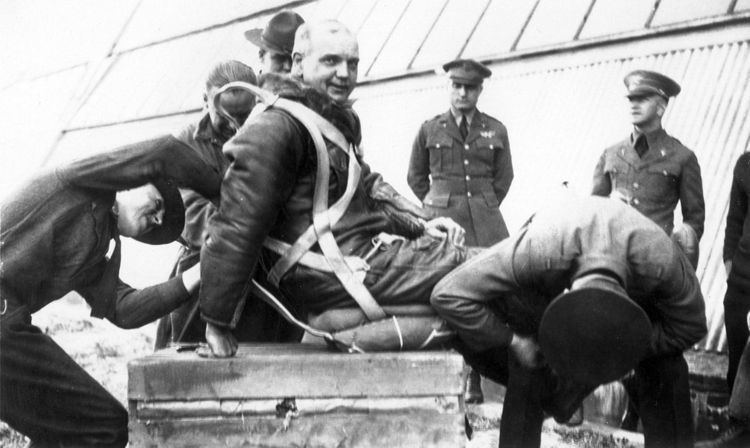Years of service 1915-1927 | Name Hawthorne Gray Died 1927 | |
 | ||
Born February 16, 1889Pasco, Washington ( 1889-02-16 ) Awards | ||
Allegiance United States of America | ||
Hawthorne Charles Gray (February 16, 1889 – November 4, 1927) was a captain in the United States Army Air Corps. On November 4, 1927, he succeeded in setting a new altitude record in a silk, rubberized, and aluminum-coated balloon launched from Scott Field near Belleville, Illinois, reaching 42,470 ft (12.94 km), but died during his descent after his oxygen supply became depleted. The record was recognized by the National Aeronautical Association, but not by the Fédération Aéronautique Internationale because the dead aeronaut "was not in personal possession of his instruments." Gray was posthumously awarded the Distinguished Flying Cross for his three ascents on March 9, May 4 and November 4.
Contents
Early life and career
Gray was born on February 16, 1889 in Pasco, Washington. He was the son of William Polk Gray (1845-1929), a prominent steamboat captain in the Northwestern United States, and Oceana Falkland Bush. Hawthorne Gray was a graduate of the University of Idaho.
Gray served as an officer in the Idaho National Guard and enlisted in the United States Army in 1915, serving as an infantry private in the Pancho Villa Expedition of 1916. Gray was commissioned a second lieutenant on June 2, 1917, and transferred with the rank of captain to what was then the United States Army Air Service in 1920. He began piloting balloons in 1921. He placed third in the 1926 National Balloon Race and second in the 1926 Gordon Bennett balloon race.
Record-setting balloon flights
On March 9, 1927, Gray set an unofficial altitude record of 28,510 ft (8.69 km) in a balloon launched from Scott Field, but passed out from hypoxia in the thin air, regaining consciousness only just in time to drop ballast and slow his fall after the balloon descended on its own. On May 4, Gray set an unofficial record for highest altitude reached by a human being, as he attained 42,470 ft (12.94 km) in a balloon over Belleville. Because of the rapid descent of the balloon, Gray parachuted out at 8,000 feet, disqualifying him from recognition by the Fédération Aéronautique Internationale (FAI), which required that the balloonist land with his craft.
On November 4, Gray attempted to set an official record. After reaching an altitude of 40,000 feet, he lost consciousness and died. His body was found in the balloon basket in a tree near Sparta, Tennessee, the next day. The balloon's barographs showed that Gray had reached a height between 43,000 and 44,000 feet. There were various theories about the cause of Gray's death. He may have severed his oxygen hose accidentally while cutting open bags of sand ballast. It is also possible that Gray became too cold and tired to open the valve on one of his oxygen tanks, or that an internal organ was ruptured by decreasing pressure. Aeronaut Albert Leo Stevens believed that Gray died during descent or on impact. The Scott Field board of inquiry which investigated Gray's death concluded that he died because his clock stopped, causing him to lose track of his time on oxygen and exhaust his supply.
Gray was posthumously awarded the Distinguished Flying Cross and buried in Arlington National Cemetery.
Personal life
Gray was married to Miriam Lorette Maddux. They had a son, John Maddux Gray, who died when he was a year old. Gray was survived by his widow and three other sons.
